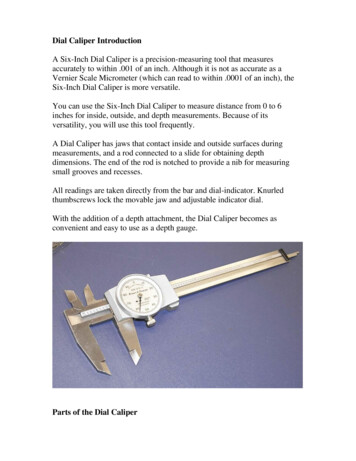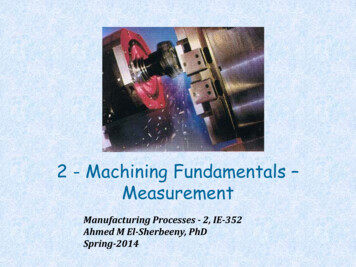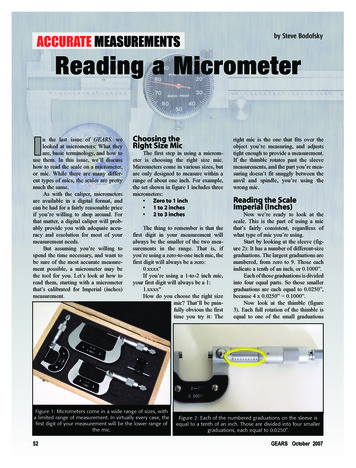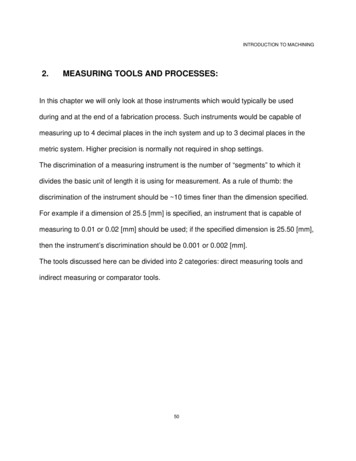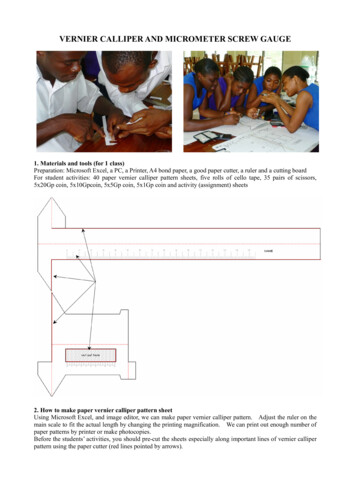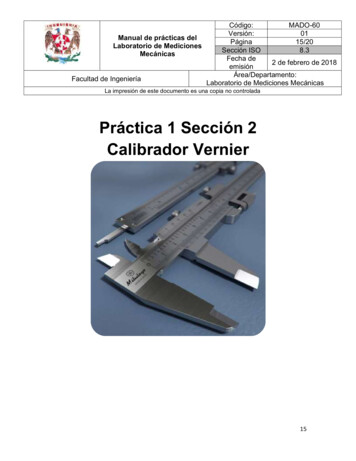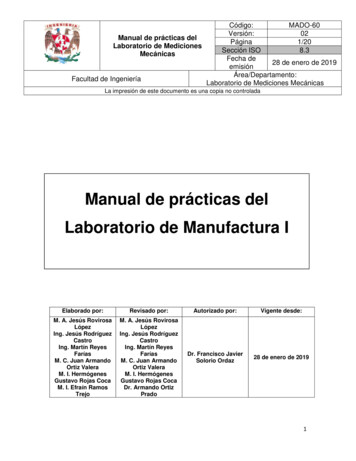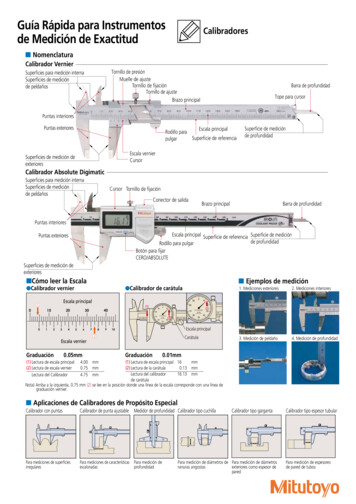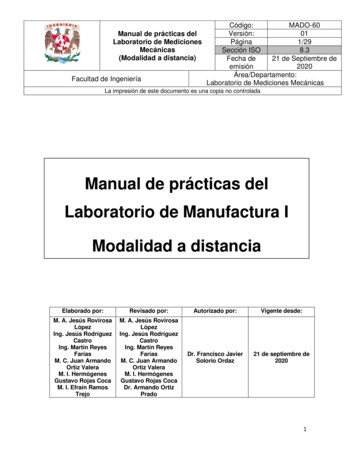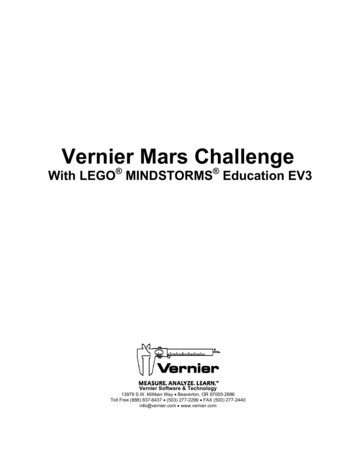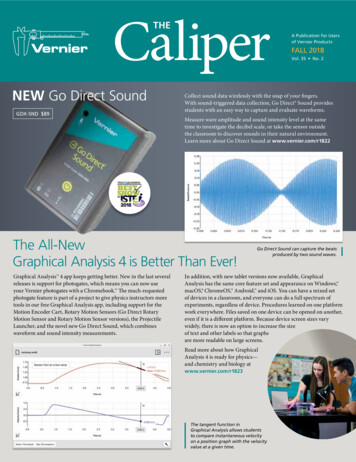
Transcription
CaliperTHENEW Go Direct SoundGDX-SND 89FALL 2018Vol. 35 No. 2Collect sound data wirelessly with the snap of your fingers.With sound-triggered data collection, Go Direct Sound providesstudents with an easy way to capture and evaluate waveforms.Measure wave amplitude and sound intensity level at the sametime to investigate the decibel scale, or take the sensor outsidethe classroom to discover sounds in their natural environment.Learn more about Go Direct Sound at www.vernier.com/r1822The All-NewGraphical Analysis 4 is Better Than Ever!Graphical Analysis 4 app keeps getting better. New in the last severalreleases is support for photogates, which means you can now useyour Vernier photogates with a Chromebook. The much-requestedphotogate feature is part of a project to give physics instructors moretools in our free Graphical Analysis app, including support for theMotion Encoder Cart, Rotary Motion Sensors (Go Direct RotaryMotion Sensor and Rotary Motion Sensor versions), the ProjectileLauncher, and the novel new Go Direct Sound, which combineswaveform and sound intensity measurements.A Publication for Usersof Vernier ProductsGo Direct Sound can capture the beatsproduced by two sound waves.In addition, with new tablet versions now available, GraphicalAnalysis has the same core feature set and appearance on Windows, macOS, ChromeOS, Android, and iOS. You can have a mixed setof devices in a classroom, and everyone can do a full spectrum ofexperiments, regardless of device. Procedures learned on one platformwork everywhere. Files saved on one device can be opened on another,even if it is a different platform. Because device screen sizes varywidely, there is now an option to increase the sizeof text and other labels so that graphsare more readable on large screens.Read more about how GraphicalAnalysis 4 is ready for physics—and chemistry and biology atwww.vernier.com/r1823The tangent function inGraphical Analysis allows studentsto compare instantaneous velocityon a position graph with the velocityvalue at a given time.
Go Direct Sensors Can Be UsedWith LabQuest 2!You already know that Go Direct sensors are the most versatilesensors around—they can be used via USB or Bluetooth wirelesstechnology on Chromebooks, computers, iOS, and Android devices. But did you know that they can now be used withLabQuest 2?Imagine studying motion with Go Direct Sensor Carts, testingacids and bases with Go Direct pH, or wading into a stream withGo Direct Optical Dissolved Oxygen, all without wires. You caneven mix and match Go Direct sensors and LabQuest sensors onLabQuest 2 for maximum flexibility. Just update your LabQuest Appto version 2.8.3 or newer, and your students can connect Go Directsensors wirelessly or by USB. (Some older LabQuest 2 interfacesrequire additional hardware to communicate with Go Directsensors wirelessly.)Download the latest LabQuest update at www.vernier.com/r1824Students gather data alonga transect in their schoolyard.The Centripetal Force Apparatus Goes WirelessThe new Go Direct Centripetal Force Apparatus makes it easierthan ever to investigate rotational dynamics. To investigate therelationships among force, mass, and radius wirelessly, all you need isthe Centripetal Force Apparatus, a Go Direct Force and AccelerationSensor, and a device running our free Graphical Analysis 4 app.With Go Direct Force and Acceleration mounted on the apparatus’beam, you are ready to investigate centripetal acceleration. Attachthe mass carriage, and you can explore Newton’s second law as itapplies to rotational dynamics—no tangled wires to worry about.Learn more about the Go Direct Centripetal Force Apparatus atwww.vernier.com/r1827GDX-CFA 299Applying a curve fit to the raw data will provide studentswith clues to the nature of this relationship.22 Fall 2016THE CALIPER VernierTHE CALIPER FALL2018 Software & Technology www.vernier.comVernier Software & Technology www.vernier.com
I N N OVAT I V E U S EVideo Analysis of Loop-the-LoopRichard Born, from DeKalb, Illinois, has written another greatexperiment that uses data taken with Video Physics on iOS andthen analyzes it with Logger Pro. He mounts an inexpensiveflashing LED on a Hot Wheels toy car and sends it through aloop-the-loop. After video analysis, you get some interesting graphs.Download the complete experiment with sample videos atwww.vernier.com/r1825Olympic Gold Medal ExperimentJessie Diggins, who won a gold medal in the recent WinterOlympics, allowed Pivot Interactives to use the medal in a versionof the Archimedes experiment. A new activity challenges studentsto identify the real gold medal from an inexpensive copy and todetermine if an Olympic gold medal is actually made of gold.Give it a try at www.vernier.com/r1826Did you know?Log in or sign up for an account atwww.vernier.com/account and take advantageof all the new features:AAPT Photo ContestThe 2018 AAPT Photo Contest, sponsored by Vernier, was heldat the summer meeting of the American Association of PhysicsTeachers in Washington, D.C. Students submitted photos thatdemonstrate physics concepts, along with essays that explain them.AAPT members voted on the entries. Each year we are impressedby the creativity of the students who enter this contest. Theeye-drawing composition of these images reminds us that arthas both an important role in our lives and a valuable connectionto science. Download the latest version of your software. Send download links to your students orIT department. Access electronic versions of your lab books. Create wish lists to use when fundingbecomes available. Find workshops in your area. Sign up for free web-based professionaldevelopment.Vernier Software & Technology www.vernier.comThe winner of the ContrivedCategory is Nicolas Gonzalez forthe photo “Finger Pickin’ Good.”Yining Lu won the NaturalCategory with the photo“Magic Light.”For details about the contest and to see all the photo winnersfor 2018, go to www.vernier.com/r1828THE CALIPER FALL 20183
Why Teach Coding in the Classroom?22 STEMactivitiesincluded withpurchaseof mBotYou don’t have to spend much time oneducation websites, blogs, or social mediabefore you run into the term coding. Whyis coding, or computer programming,getting so much attention right now?Coding engages students in new ways,providing practical applications formath and science skills.The act of coding—an iterative process ofbuilding, testing, and refining a program—parallels the scientific method in manyrespects. Students must construct detailedmodels, plan carefully, anticipate sources oferror, analyze data, and document theirwork. Additionally, many programmingprojects require the application of specificscience knowledge, such as understandingthe motion of a uniformly acceleratingobject, in order to successfully accomplisha task.Programmable robots, such as mBot and mBot Ranger from Makeblock, are agreat, hands-on way to introduce coding tostudents because robots take abstract codefrom the screen and translate it into actionsin the real world. The newest member of theMakeblock family of robots is Codey Rocky,perfect for elementary- and middle-schoolstudents who are new to coding. CodeyRocky does not require any constructionand can be programmed through a free appon computers, tablets, or smartphones.See more about what we offer for coding atwww.vernier.com/r1829Robots and Grade Level mBot, K–8 and High School mBot Ranger, Middle and High School Codey Rocky, K–8 Neuron Inventor Kit, K–8I N N OVAT I V E U S EDetermine Pitch and Rollwith LabVIEW and Go Direct AccelerationCombining the power of LabVIEW software with the flexibility of our wireless Go Direct sensors opens the door to engaging coding projects and unique monitoring applications.On our website, you can find free LabVIEW code that can help you and your studentsincorporate Go Direct sensors into custom LabVIEW programs.A nice example of combining LabVIEW with Go Direct sensors is a program that determinesthe pitch and roll of a toy airplane using the readings from Go Direct Acceleration.GDX-ACC 99Find out how at www.vernier.com/r1830Taking Project-Based Learning to New Levels with VernierBy George Hademenos,Richardson High SchoolIn my 17-plus years of teaching, I havefound that project-based learning is one ofthe most effective instructional approachesto engaging students in STEM education.Students really start to understand—andmaster—the concepts being taught in classwhen they are given the opportunity tocollect, display, and analyze data in aninteresting, relative, and hands-on way.44 Fall 2016THE CALIPER VernierTHE CALIPER FALL2018 Software & Technology www.vernier.comThe ROAVEE (Remotely OperatedAmphibious Vehicle for EnvironmentalExploration) project is a great example ofeffective project-based learning in action.Students are challenged to design, model,construct, test, and navigate a roboticvehicle. The goal is for the ROAVEE tocollect environmental data from areas noteasily or safely accessible to students, such asin a lake and inside a drainage tunnel. Moredetails about this project, including a video,are available at www.vernier.com/r1831Vernier Software & Technology www.vernier.com
Vernier Structures & Materials Tester Usedin Nashville Bridge CompetitionBy Janey Camp, Vanderbilt EngineeringFaculty MemberOn March 3, 2018, the Nashville Branch ofthe American Society of Civil Engineers(ASCE) hosted its 10th Music City BridgeCompetition with 54 bridges submittedfor qualifications testing and 38 bridgestested to failure. The competition is opento any and all high school students inMiddle Tennessee and serves as a qualifyingcompetition for the Illinois Institute ofTechnology’s International Bridge BuildingContest. Winners of the Music City BridgeCompetition are based upon a calculatedefficiency of how much mass the bridgeholds divided by the mass of the bridge.For the past two years students have usedthe Vernier Structures & Materials Tester(VSMT) to test their bridges. The VSMTallows students to test bridges fasterand easily display the results of bridgeperformance.Learn about this year’s winners atwww.vernier.com/r1832What’s New with the DCU?VernierEngineering AwardWin a 5,500 Awardfrom VernierAre you using Vernier sensors tointroduce engineering concepts orengineering practices to your middleschool, high school, or college students?If so, you could win a 5,500 award.Maybe you are reading Vernier sensordata with Scratch to introduce coding,controlling digital outputs withLogger Pro software, integrating NGSSengineering practices, or using yourVernier sensors with a robotics platformsuch as LEGO, VEX, or Arduino. Tellus about your project, and you might win!The award consists of an award trophy, 1,000 in cash, 3,000 in Verniertechnology, and 1,500 toward expensesto attend either the annual NSTA STEMconference or the annual ASEE conference.For complete rules, to view videos frompast winners, and to submit an onlineapplication and video showcasing yourentry, go to www.vernier.com/r1834once again expanded the DCU’s capability.Wirelessly connect your Go Direct sensor(s)to LabQuest 2, connect the DCU toLabQuest 2, and program the DCU to turnon components based on the sensor values.You can now use our wireless Go Directsensors with the Digital Control Unit(DCU) to control small electronic devices(e.g., motors, LEDs, and lights). Last year,you may recall, we added the capability tocontrol the DCU from LabQuest 2. Thisyear, when LabQuest 2 gained the abilityto connect with Go Direct sensors, weWith Go Direct sensors and the DCU, youcan use output from a heart rate monitorto light up LEDs that help test subjectsmaintain a target heart rate. Or, if yourstudents struggle to stay awake, you canhave them create an alarm that triggerswhen carbon dioxide levels get too high inyour classroom. You could even program afan to turn on and bring in some fresh air!Learn more at www.vernier.com/r1833Robotic Hand ProjectWe have had a lot of fun with the Robotic Hand project, which we discovered in theHacking STEM Library from Microsoft. Using our Low-g Accelerometer, an Arduino, and our Vernier Arduino Interface Shield, we modified the project to create an easiercontrol system.See this robotic hand in action at www.vernier.com/r1835Vernier Software & Technology www.vernier.comTHE CALIPER FALL 20185
I N N OVAT I V E U S EDiscover the WavelengthPivot Interactives Adds ChemistryHave you ever done an experiment that you wish you could repeatwith different chemicals or concentrations but lacked the timeand materials? This is where Pivot Interactives new activities forchemistry can become a valuable teaching tool.Pivot Interactives is a browser-based collection of videos andanalysis tools that enable students to control real results—notsimulations. The videos come with appropriate tools for measuringAbsorbance vs. wavelength of a blue solution with wavelengthof maximum absorbance selectedWhen conducting Beer’s law and kinetics experiments, students mustchoose a specific wavelength to conduct the experiment. Studentsare expected to understand and explain why they would choose onewavelength over another. A spectrophotometer, such as Go DirectSpectroVis Plus, is just the tool for this. Unfortunately, many schoolscan’t afford a class set of spectrophotometers. So how can you use asingle spectrophotometer and a class set of Colorimeters to have yourstudents discover the best wavelength of light to use?We’ve written an experiment that allows you to do just that. Usinga colored solution, your students will test each wavelength ontheir Colorimeter, then record and compare the absorbance ateach wavelength. You will capture an absorbance spectrum with aspectrophotometer for the same solution that the students are using.The discussion that follows should help your students understandwhy they would choose one wavelength, λ max , over another for aparticular solution and also for a specific experiment.Students use Beer’s law to measure the concentration of solutions.volume, mass, temperature, time, and even color intensity. Thereare additional tools to carefully control the progression of the videoand experiment. Online tables and graphs are used for students tograph relationships between the variables being studied. Calculatedcolumns can be built and graphed.Learn more at www.vernier.com/r1837Download this experiment at www.vernier.com/r1836The Vernier Advantage for College ChemistryWhether you are teaching general or upper-level college chemistrycourses, our affordable sensors and instrumentation make itpossible for every student to participate in hands-on learning.Our combination of sensors, software, college-level experiments,and instructional resources engage students and instructors inscientific discovery. We have assembled a collection of products andexperiments for commonly taught college chemistry courses. General Chemistry: Complete an acid-base titration with our pHprobes that have 0.1 pH unit accuracy and a drop counter thataccurately converts drops to volume. Organic Chemistry: Measure and analyze the GC retention timesof a Fischer esterification reaction mixture using the Mini GC PlusGas Chromatograph with room air as the carrier gas. Biochemistry: The Vernier UV-VIS Spectrophotometer can beused to measure the 260/280 nm ratio when purifying proteins andDNA. Its range, 220 nm to 850 nm and 3 nm optical resolution,makes it ideal for biological applications. Analytical Chemistry: Investigate redox reactions with apotentiometric titration using an ORP (oxidation-reductionpotential) sensor. Physical Chemistry: Explore excited-state dynamics with one ofour free experiments that walks students through the heavy-atomquenching of quinine fluorescence using the Vernier Fluorescence/UV-VIS Spectrophotometer.A full list of recommendations for college chemistry is available atwww.vernier.com/r183866 Fall 2016THE CALIPER VernierTHE CALIPER FALL2018 Software & Technology www.vernier.comVernier Software & Technology www.vernier.com
Vernier in the Science JournalsHeat Evolution and ElectricalWork of Batteries as a Functionof Discharge Rate: Spontaneousand Reversible Processes andMaximum WorkRobert J. Noll and Jason M. Hughes;J. Chem. Educ., 2018, 95, pp 852 857.This article describes an experiment inwhich students compare the enthalpychange of the useful electrical work to theheat lost from the electrochemical reactionin batteries.Featured products: Current Probe, VoltageProbe, Stainless Steel Temperature ProbeMeasuring the Force betweenMagnets as an Analogy forCoulomb’s LawSamuel P. Hendrix and Stephen G.Prilliman; J. Chem. Educ., 2018, 95,pp 833 836.The authors describe a simpledemonstration to illustrate the relationshipbetween charged particles as described byCoulomb’s law. They use a Dual-Range ForceSensor mounted on a LEGO platform.Featured products: Dual-Range Force SensorFlexible Experiment IntroducingFactorial Experimental DesignPenny Snetsinger and Eid Alkhatib;J. Chem. Educ., 2018, 95, pp 636 640.an experiment that studies the effect ofactivated carbon on dyes.Featured product: Go Direct SpectroVis Plus SpectrophotometerPhysicians as the First AnalyticalChemists: Gall Nut ExtractDetermination of Iron Ion (Fe2 )ConcentrationMary T. van Opstal, Philip Nahlik,Patrick L. Daubenmire, and Alanah Fitch;J. Chem. Educ., 2018, 95, pp 456 462.This article describes a guided inquiryactivity that measures the iron in drinkingwater, using oak gall nut extract. Thisactivity is geared toward students who areinterested in medical careers.Featured product: Go Direct SpectroVis PlusSpectrophotometerPhysics Meets Art in theGeneral Education CoreMarta L. Dark and Derrick J. Hylton;Journal of College Science Teaching,2018, (47) 3.If you take the Physics and the Arts courseat Spelman College in Atlanta, Georgia,you will be exposed to many applications ofa traditional physics class as they apply tovarious areas in the arts.Featured product: Go Direct SpectroVisPlus SpectrophotometerThe goal of this activity is to providestudents with the opportunity to designFor more articles, visit www.vernier.com/r1839Follow @VernierST on TwitterEnhancing a ScientificInquiry Lesson ThroughComputer-SupportedCollaborative LearningKathleen Koenig, Janet MannheimerZydney, Doug Behr, and Lei Bao;Science Scope, September, 2017.In this guided inquiry activity, studentslearn about energy transformations asthey apply to renewable energy.Featured product: KidWind Basic WindExperiment KitWhere Does The Energy Go?Marta R. Stoeckel (Tartan High School,Oakdale, MN); The Science Teacher,Vol. 85, No. 1, January, 2018.This article explains how to useevidence-based reasoning to study thebounce of a ball. It is linked to NGSSstandards and the authors use Logger Pro 3video analysis to plot a ball’s position.Featured product: Logger Pro softwareBurst Mode CompositePhotography for DynamicPhysics DemonstrationsJames Lincoln; The Physics Teacher,May, 2018.Many cell phone cameras support burstmode. This allows them to take a seriesof photos in rapid succession. This articleexplains how to use this feature to createinteresting composite photos, which canbe analyzed using our photo analysis inLogger Pro.Featured product: Logger Pro softwareSubscribe to @verniervideo on YouTubeChris Lenius (@LeniusC) of Chaska High School, Chaska, MinnesotaVernier Software & Technology www.vernier.comTHE CALIPER FALL 20187
Study Photosynthesis and Respiration with Bio-Rad AlgaeBeads and Go Direct SpectroVis Plus SpectrophotometerI N N OVAT I V E U S EAlgae beads, along with the Go Direct SpectroVis Plus Spectrophotometer,provide a great way to study photosynthesis and respiration. Algaebeads consist of freshwater algal cells suspended in sodium alginateand hardened in calcium chloride solution. In this suspension, thealgal cells can still undergo cellular respiration and photosynthesis,exchanging gases with the liquid around them. Traditionally, a CO2indicator solution is used to qualitatively observe that dissolvedCO2 increases during cellular respiration and decreases duringphotosynthesis. However, in an experiment we’ve adapted from theBio-Rad Explorer Program, students use a Go Direct SpectroVisPlus Spectrophotometer to quantify these changes.In the experiment, algae beads are placed in cuvettes containingCO2 indicator solution and incubated either in the dark or thelight. Students measure the absorbance once every 5 minutesusing Go Direct SpectroVis Plus Spectrophotometer and ourfree Spectral Analysis app.Download the experiment at www.vernier.com/r1840Easily Record and Analyze EMGswith Go Direct EKGSample data illustrate the inverse relationship between dissolved CO2concentration and exposure to light.What Are the Best Light SourcesFor Photosynthesis?Photosynthetic organisms such as plants and algae useelectromagnetic radiation from the visible spectrum to drive thesynthesis of sugar molecules. Special pigments in chloroplastsof plant cells absorb the energy of certain wavelengths of light,causing a molecular chain reaction known as the light-dependentreactions of photosynthesis. The best wavelengths of visiblelight for photosynthesis fall within the blue range (425–450 nm)and red range (600–700 nm). Therefore, the best light sourcesfor photosynthesis should ideally emit light in the blue andred ranges. In this study, we used a Go Direct SpectroVis PlusNormal and rectified EMGs recorded from the forearmMany teachers are interested in using our EKG sensors to recordan electromyogram (EMG), the electrical activity produced frommuscle contractions. Recording an EMG is straightforward, but thereare multiple ways that an EMG can be analyzed. The most robusttechnique is to measure the integral of the rectified EMG signal,which can easily be done using Go Direct EKG.A normal EMG has both positive and negative deflections. A rectifiedEMG uses a function that makes all of the EMG deflections positive.In the past, we have offered special Logger Pro and LabQuest filesthat provide the proper filtering and calculated column supportto record and analyze rectified EMGs. But, Go Direct EKG makesrecording rectified EMGs much simpler. No special files or filtersettings are required—just change the channel to EMG Rectified andstart collecting data. Then simply measure the integral of the signalin Graphical Analysis.Spectrophotometer with a Vernier Spectrophotometer OpticalFiber and LabQuest 2 to collect spectra from four different lightsources. This allowed us to determine the wavelengths emitted byeach source and to determine which ones would be the best forphotosynthesis.Find out how at www.vernier.com/r1841Learn more at www.vernier.com/r184288Relative light intensity of four light bulbs across the visible spectrum Fall 2016THE CALIPER VernierTHE CALIPER FALL2018 Software & Technology www.vernier.comVernier Software & Technology www.vernier.com
GLOBE TakesGo Direct to the FieldIn July, more than 100 students from 35countries used our Go Direct sensors to testthe water in Ireland’s Killarney NationalPark as part of the 2018 GLOBE LearningExpedition (GLE). This event is part of theVernier Sponsors the 2018 KidWind ChallengeTo inspire students to learn about renewable energy and hone their engineering skills,Vernier supported the 2018 KidWind Challenge, hosted by the KidWind Project. Thechallenge consists of dozens of local and regional competitions across the country,called KidWind Challenges, during which teams of students test the energy outputof wind turbines they design and build. Students also present their design processesto a panel of judges and participate in short design or problem-solving tasks called“Instant Challenges.”Learn about this year’s winners at www.vernier.com/r1843I N N OVAT I V E U S EVernier Sensors Used in NASA Inquiry LabsDan Rosales at American Canyon High School in Napa County, California, wasrecently featured on KQED Education for teaching a series of six NASA inquiry labsabout the science of climate change. The labs use Vernier sensors across the schoolcurriculum in Anatomy/Physiology, AP Environmental Science, AP Chemistry,and STEM Club.See all six activities about climate change at www.vernier.com/r1844Free ClimateChange ResourceThe Paleontological Research Institutionin Ithaca, NY, has produced its latest bookin the Teacher-Friendly Guides series,The Teacher-Friendly Guide to ClimateChange.This guide has many useful resources forincorporating climate change lessons intoscience programs and has been mailedto science teachers at every school inseven states. It is also available as a freedownload at www.vernier.com/r1845Vernier Software & Technology www.vernier.comStudents from Croatia and Japan use Go Directsensors in Killarney National Park.GLOBE Program and is held every few yearsin different locations around the world. TheGLE brings together students, teachers, andscientists for a week of sharing and learningabout science, the environment, and eachother’s cultures. As part of this year’s studentfield experience, Go Direct sensors were usedto measure temperature, pH, conductivity,and dissolved oxygen levels along the DeenaghRiver. This beautiful river runs along the edgeof the park, near the town of Killarney. Thestudents’ sensor data, along with a surveyof macroinvertebrates, indicated that theDeenagh is in excellent health.Learn more at www.vernier.com/r1846Vernier Sponsors NABTEcology/EnvironmentalScience Teaching AwardOnce again, Vernier is sponsoring theNABT Ecology/Environmental ScienceTeaching Award. The award includes 500toward travel to the NABT ProfessionalDevelopment Conference and 1,000in Vernier equipment. Applications forthe 2019 award will be available on theNABT website soon after the Novemberconference, and the deadline forsubmission is March 15, 2019. Details areavailable at www.vernier.com/grantsTHE CALIPER FALL 20189
Our CEO Celebrates His 25th Anniversary at VernierJohn discusses the benefits of our Go Directfamily of sensors. See the interview atTeachWithVernier.comJohn Wheeler with Dave and Christine Vernierand the rest of the Vernier staff in the late 1990s.John Wheeler, our CEO, first workedfor Vernier as a consultant. For hisfirst project he designed a photogatetiming device, for which we paid himwith one Macintosh computer. In 1993,he became a full-time employee, whenwe had fewer than 10 employees. Johnhandled our parts purchasing, but healso continued to design products. Overthe years, John has designed the SerialBox Interface, the LabPro interface,LabQuest, LabQuest 2, and most ofour sensors. In 2015, he took on theoverall leadership role at Vernier.Read more about his experiences at25 Years Ago inthis NewsletterIn the Fall 1993 issue of The Caliper,we introduced our Serial BoxInterface (Dave Vernier’s favoriteproduct name ever. Get it? CerealBox). It was an inexpensive wayto connect analog sensors liketemperature probes and pH probesto the serial port of an MS-DOSor Mac computer. We were alsostarting to do more in chemistry andintroduced our first colorimeter inthat issue.www.vernier.com/r1847“WScience Humorhile we have grown significantlysince when I first started, theA dung beetle walks intoa bar and says,“Excuse me, is this stool taken?”amazing thing is that we have beenable to grow and keep our companyculture. David and Christine Vernierstarted something really special andhave nurtured it for 37 years to get towhere we are now. We have kept ourTeenager #1:Did you hear Oxygen andMagnesium got together?Teenager #2:OMg!company values, and we continueto serve educators and impactstudent learning.”–John Wheeler, CEOWind Turbine #1:What kind of music do you like?Wind Turbine #2:I’m a big metal fanSoftware UpdatesWe regularly release software updates to support new sensors, add new features, and fix the occasional bug. Keeping up to datewith software releases is one way to keep things running smoothly in your classroom or lab. Have you updated your Vernierapplications in the last few months? Updates are free, and with the shipping of new Go Direct sensors, we’ve released updatesfor nearly all our software. For updates to Logger Pro for macOS and Windows, as well as for LabQuest App, visit www.vernier.com/downloads Graphical Analysis 4 for macOS and Windows detects the availability of an update and notifies you with a red dot on theoverflow menu, found under the three dots in the upper right. To update Chrome, iOS, and Android applications, including Graphical Analysis 4 app, search the appropriate app store. Updateswill eventually be applied automatically, but you can be sure of the current version by deleting and reinstalling the app.Special note for iOS and Android users: We are transitioning from our original Graphical Analysis app to a new version that sharesfeatures and appearance across all platforms. The transition requires that we have two versions of the apps available simultaneouslyin the stores. If you installed Graphical Analysis before July 2018, the app will not update to the new version. Instead, search theappropriate app store and freshly install the new app called Graphical Analysis (the older app will automatically update and berenamed GraphicalGW). When we release updates of Graphical Analysis in the future, the app will automatically update as expected.Additional information can be found at www.vernier.com/til/41771010 Fall 2016THE THECALIPER 2018Vernier Software & Technology www.vernier.comCALIPER FALLVernier Software & Technology www.vernier.com
ProfessionalDevelopmentWorkshopsStateCalling all science educators! Step out of your classrooms, roll upyour sleeves, and join us for a free four-hour, hands-on exploration ofthe latest and greatest in probeware and data-collection technology,including our new Go Direct sensors with multiple options forconnectivity. Learn how to integrate Vernier technology into yourchemistry, biol
Olympic Gold Medal Experiment Jessie Diggins, who won a gold medal in the recent Winter Olympics, allowed Pivot Interactives to use the medal in a version of the Archimedes experiment. A new activity challenges students to identify the real gold medal from an inexpensive copy and to determine if an Olympic gold medal is actually made of gold.
